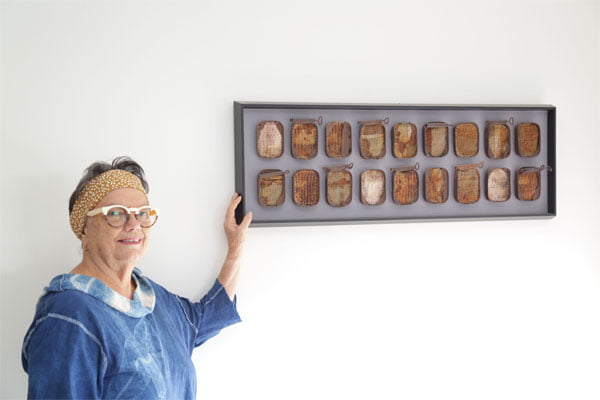There’s mounting evidence that demonstrates how being creative positively impacts your well-being. For VisAbility client 73-year-old artist Marianne Penberthy, her fibre textile art has helped her heal following a stroke that led to severe vision loss, memory and mobility issues.
“Art is therapeutic and restorative and connects the brain to my hands. I particularly like shibori, a Japanese technique of tying, gathering or twisting a piece of cloth before dying it. A nurse will use stitches to mend a wound. I am stitching to heal my wounds.”
According to The Stroke Foundation (link opens in new window), one-third of stroke survivors will suffer vision loss. A stroke occurs when a blood vessel that carries oxygen and nutrients to the brain is either blocked by a clot or bursts.
VisAbility Occupational Therapist Keearny Maher offers support to Marianne in Geraldton, travelling up regularly to see her in her own home.

“Most strokes, like Marianne’s, will affect one side of the brain but impact both eyes because nerves from each eye travel together in the brain. Marianne’s stroke affected the right side of her brain, so she suffered vision loss on the left side of both her eyes. People who have a stroke on the left side will have vision loss to the right side of both eyes,” she explains.
Marianne’s stroke caused homonymous hemianopia leading to visual field loss. Visual field loss means you can’t see a section of your vision – just the right or left half of the objects in your sightline.
Optical aids such as magnifiers, improved lighting and eye and compensatory visual scanning training can help people make the most out of their remaining sight. In Marianne’s case it led to Marianne enjoying her textile artwork once again.
Marianne’s story
Marianne has a strong interest in art and the dramatic Australian landscape. After she married, she travelled around Australia, visiting Elcho Island and Croker island and became close to the Yolngu and the Yammirr people, local indigenous communities.

She immersed herself in ceramics selling her work at a local gallery in Kalbarri before relocating to Geraldton. In her mid-forties, she went to Perth to study for a Bachelor’s Degree in Visual Arts and Textiles.
“Looking back, it was an unusual thing to do. I left my boys, then aged 11 and 13, but I received my husband’s blessing.”
On her return, Marianne accepted the role of the joint coordinator of the indigenous art and design course at Geraldton Regional TAFE. Her textile artwork was featured in exhibitions internationally, interstate and West Australia.
In 2017, her husband of 48 years, Ray, was diagnosed with lung cancer and died just months later.
“The stress and trauma led to my stroke. I had a bleed on the right side of my brain that impacted the left side of my body.”
She recalls the months after his death and describes them as ‘Dark times’. Marianne couldn’t walk and had constant brain fog along with vision loss.
Strokes and vision loss
A referral was made to VisAbility. Five years on, Marianne is in a better place.
“A variety of support has helped me day-to-day. This has included eye and visual tracking exercises, therapy to develop my fine motor skills and a greater understanding of how improved lighting could help me at home.”
An orientation and mobility instructor taught Marianne how to use a white cane to ‘feel’ her way around, navigate steps, find doorways and use public transport. Assistive technology has meant Marianne can continue to teach textile art. One of Marianne’s first art creations following her stroke was a crocheted mat stitched together from t-shirts worn by her late husband.
“It was significant because it was about making, mending and healing,” she explains.

“Since my stroke and vision loss, my sense of touch has become more important. I’ve adapted my artwork to suit my condition. I may not be able to stitch straight anymore, but if it’s wonky it doesn’t matter. I’ve retrained myself to work with what vision I have left.”
Facts about vision loss and stroke
- A stroke usually affects both eyes because the visual pathways travel from one side of both eyes to the brain.
- Around 20% of people who suffer a stroke will have a permanent visual field deficit in their peripheral vision.
- Improved lighting is one of the biggest things to assist someone with vision loss. An occupational therapist can offer tips and strategies to work around an individual’s vision problems. For example, making someone aware of their blind spots, so they look towards their weaker side.
- If someone already has cataracts or glaucoma, vision may deteriorate further following a stroke.
- A stroke may also affect how your brain processes information. For example, scanning sentences the wrong way.
How to get support
Please complete the form below to make an initial enquiry about the low vision services and support we can provide. We have a dedicated Client Experience Team who will contact you to discuss your individual needs.
If you are a provider and wish to refer a client, please use our low vision medical certificate (online referral form) to make your referral.
